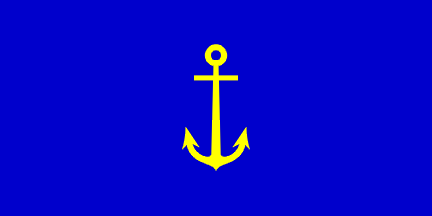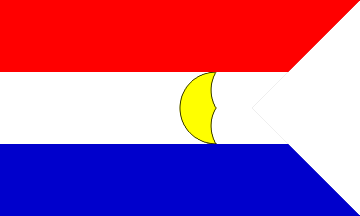Paraguayan Navy admiral rank flags (original) (raw)

This page is part of © FOTW Flags Of The World website
Last modified: 2015-01-17 by alex garofolo
Keywords: [chief of the fleet](keywordc.html#chief of the fleet) | [anchor (yellow)](keyworda.html#anchor %28yellow%29) | admiral | [crescent (yellow)](keywordc.html#crescent %28yellow%29) | vice-admiral | [inspector general of the navy](keywordi.html#inspector general of the navy) | [star: 5 points (yellow)](keywords.html#star: 5 points %28yellow%29) | [stars: 3 (yellow)](keywords.html#stars: 3 %28yellow%29) | [stars: diagonal](keywords.html#stars: diagonal) | rear-admiral |
Links: FOTW homepage |search | disclaimer and copyright | write us | mirrors
- Chief of the Fleet
- Admiral (as of 1917)
- Vice-Admiral
- Rear-Admiral
- Admiral not in Command See also:
- Paraguayan Navy medium rank flags
- Paraguayan Navy
- Paraguay
Chief of the Fleet

image by Željko Heimer, 25 Oct 2002
Shown in [pay00]: 1:2 blue flag with a yellow anchor in the middle. This position was not noted in Neubecker 1939 [neu92].
Željko Heimer, 25 Oct 2002
Shown also in Album 1995 recapitulative issue [pie95]. (Only anchor, no stars; 1:2)
Željko Heimer, 27 Oct 2002
Admiral
as of 1917

image by Željko Heimer, 29 Oct 2002
Shown in [gmc17], as image #505: Swallow-tailed red-white-blue tricolour in 333:500 ratio, with a yellow crescent in the white stripe near the fly. The crescent is of particular shape, unlike the Muslim crescents. Latter sources do not show any flag for full admirals. The first later source (that I have), the Flaggenbuch [neu92], shows already a new set of flags, blue with stars, basically the same as in use today. I suspect that this flag with a crescent might be relic from time when the admiral’s flags were hoisted on different masts to indicate different grades, and that at the time of the Great War, the Paraguayan Navy had not modernised in this sense, something that was done later, in due time to get into _Flaggenbuch_[neu92], so to say.
Željko Heimer, 06 Oct 2002
Vice-Admiral

image by Željko Heimer, 25 Oct 2002
Shown in [pay00]: 1:2 blue flag with three yelow five-pointed star set in falling diagonal (i.e. one in upper hoist corner, one in the middle of the flag and one in lower fly). Neubecker 1939 [neu92] attributes this flag also to Inspector General of the Navy. Today there may not be such function, or maybe the flag is not used (or simply the flag of the appropriate rank of the holder of the duty is used).
Željko Heimer, 25 Oct 2002
Shown also in Album 1995 recapitulative issue [pie95]. (3 stars; 1:2)
Željko Heimer, 27 Oct 2002
Vice Admiral or Inspector General of Navy (ca. 1939)

image by Željko Heimer, 28 Oct 2002
Shown in the Flaggenbuch [neu92]: 2:3 blue flag with three yellow five-pointed stars in falling diagonal.
Željko Heimer, 28 Oct 2002
Rear-Admiral

image by Željko Heimer, 25 Oct 2002
Shown in [pay00]: 1:2 blue flag with two yelow five-pointed star set in falling diagonal (i.e. one in upper hoist corner and one in lower fly). Neubecker 1939 [neu92] attributes this flag to Rear Admiral as independent commander (whatever that exactly means) and Director General of the Navy.
Željko Heimer, 25 Oct 2002
Shown also in Album 1995 recapitulative issue [pie95]. (2 stars)
Željko Heimer, 27 Oct 2002
Rear Admiral as independent commander or Director General of Navy (ca. 1939)

image by Željko Heimer, 28 Oct 2002
Shown in the Flaggenbuch [neu92]: 2:3 blue flag with two yellow five-pointed stars in falling diagonal.
Željko Heimer, 28 Oct 2002
Admiral not in Command

image by Željko Heimer, 26 Oct 2002
Shown in [pay00]: 2:3 white flag with red falling and blue rising diagonal stripe, on their intersection a white disk containing a golden five-pointed star. This is the rectangular version of the naval jack. Neubecker [neu92] does no show it in 1939, so this one might be younger then that. I wander if «not in command» means that it is used by any admiral visiting a ship who is not in ship’s vertical line of command, or, say, only by those admirals who currently does not hold any commanding function…
Željko Heimer, 26 Oct 2002
In case of the square jack the white disk covers entierly the crossing part of the diagonals. Here this can’t be done so that the disk does not reach into white field (unless the disk being eliptical, which is probably not the case). This poses the question which diagonal is in front of the other. The Album [pay00] shows, just as I follow, the red in font of the blue, and the disk slightly larger then the smallest intersection part, so reaching a bit into white field (whithout any visible fibriation - the effect of apliqueing of the disk on the flag might provide decent distinction).
Željko Heimer, 26 Oct 2002
Shown in Album 1995 recapitulative issue [pie95] in 2:3 ratio.
Željko Heimer, 27 Oct 2002